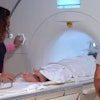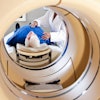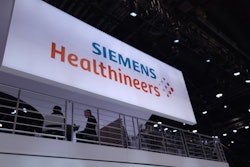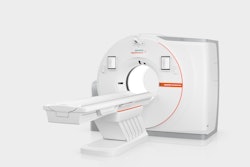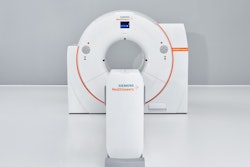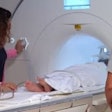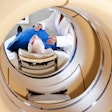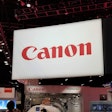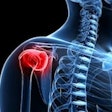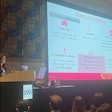CHICAGO – A new dual-source CT scanner, ultrasound system, and generative AI technology were among the highlights for Siemens Healthineers at RSNA 2023.
CT
Siemens’ new Somaton Pro.Pulse dual-source scanner took center stage in CT for Siemens. Unveiled two weeks prior to the meeting, Somaton Pro.Pulse is designed to make dual-source CT technology more accessible for smaller and rural facilities as well as outpatient diagnostic centers, according to the vendor.
The new scanner features up to 20% lower lifecycle costs due to an improved cooling system and more efficient power consumption, the company said. It also utilizes tin filters to keep radiation dose low while maintaining optimum image quality, according to the firm. Siemens noted that this benefit is especially important in clinical indications such as ultralow-dose screening chest CT exams.
 Images generated on Somatom Pro.Pulse. Image courtesy of Siemens.
Images generated on Somatom Pro.Pulse. Image courtesy of Siemens.
When used with the company's myExam Companion software, Somatom Pro.Pulse simplifies exams while personalizing scanning for each patient, Siemens said. Scan parameters are optimized based on patient data. Then, a fully assisting scanner technologies (FAST) 3D camera automatically performs patient positioning to help reduce time spent on routine tasks, according to the vendor.
In other CT news, the firm showcased version VB10 of its software for Naeotom Alpha photon-counting CT scanner. The new release, which is not yet available in the U.S., brings 10 new functionalities, including a new heart imaging reconstruction algorithm that aims to enable consistent results for various detector widths. Other cardiac imaging updates improve the performance for scanning hearts that have stents or extensive calcifications; spectral information and reconstruction of spectral results deliver more functional insights, according to the vendor.
Siemens said it intends to expand photon-scanning technology to one billion patients over the next decade. To date, 500,000 patients have been scanned with the technology worldwide, according to the vendor.
Siemens said it’s also investing $86 million (80 million euros) to expand photon-counting CT manufacturing capabilities at its facility in Forcheim, Germany.
Ultrasound
Siemens introduced Acuson Maple, a new ultrasound system that the company said was designed for the clinician who needs an affordable “workhorse” that supports a diverse range of ultrasound use cases. The system is powered by Acuson technology from the company’s established portfolio and is lightweight, portable, and battery-powered, Siemens noted.
The system supports 15 transducers and has 25 advanced features that enhance usability and streamline workflow. The integrated battery enables up to 75 minutes of unplugged system scanning. This capability may be useful in emerging markets with power supply challenges and in clinical settings that require movement between exam rooms for rapid patient assessment, the company said.
 Siemens Acuson Maple. Image courtesy of Siemens Healthineers.
Siemens Acuson Maple. Image courtesy of Siemens Healthineers.
In addition, the system’s AI machine learning-based applications are designed to improve efficiency by increasing consistency in repetitive tasks, Siemens said. For instance, in obstetrics and gynecology imaging, the system’s Auto OB feature can automatically calculates the fetus’s age and weight and reduce overall measurement time by up to 24%, the company noted. For cardiac imaging, the eSie Measure feature automatically performs cardiac measurements during routine echocardiography exam.
Acuson Maple has received clearance from the U.S. Food and Drug Administration (FDA) and the CE mark in Europe.
AI/Informatics
Siemens discussed potential generative AI applications in its booth, including a technique that utilizes generative AI to combine clinical images with reports. With this approach, a chat system could load, link, and prepare appropriate answers, reports, and images, the company said. Users can then click on an image to see the appropriate highlighted area in the report and vice versa, according to Siemens.
Furthermore, AI can dynamically generate imaging reports and prioritize them based on their importance, Siemens said. What’s more, the firm said it’s working on developing generative AI for staff training, as well as customer service and support.
Molecular imaging
In nuclear medicine and molecular imaging, Siemens showcased its latest Biograph PET/CT scanner, the Biograph Vision.X. The system received clearance from the FDA on November 22 and was first unveiled in June at the Society of Nuclear Medicine and Molecular Meeting annual meeting.
Notably, the Biograph Vision.X produces a time of flight (TOF) of 178 picoseconds – to date, the company’s fastest measured value on a single system.
In addition, the Biograph Vision.X features Siemens' Optiso Ultra Dynamic Range (UDR) detector technology. The silicon photomultipliers (SiPMs) employed in the UDR detectors enable the use of 3.2 x 3.2-mm lutetium oxyorthosilicate (LSO) crystal elements. These small LSO crystals, which are completely covered by SiPMs, yield higher spatial resolution than larger crystals, according to Siemens.
Also, the Biograph Vision.X includes the firm's AIDAN AI platform, which aims to enhance operational efficiency and accelerate patient workflow, Siemens said. The system will be available as an in-field upgrade to current users of Biograph Vision, the company noted.

